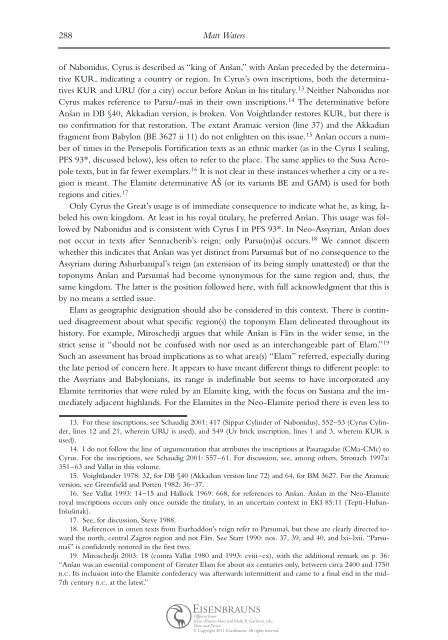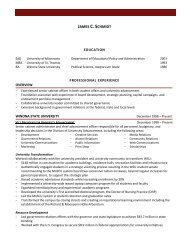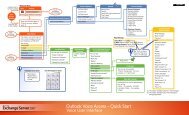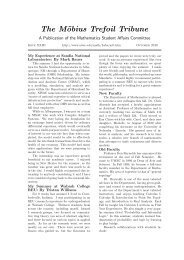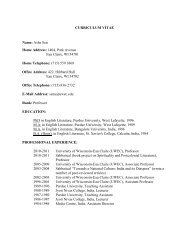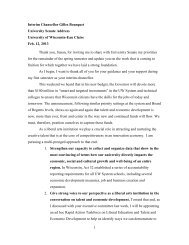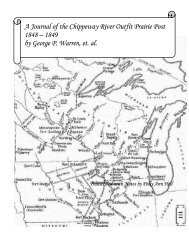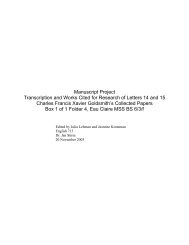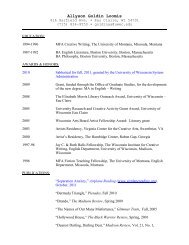Elam and Persia - University of Wisconsin-Eau Claire
Elam and Persia - University of Wisconsin-Eau Claire
Elam and Persia - University of Wisconsin-Eau Claire
Create successful ePaper yourself
Turn your PDF publications into a flip-book with our unique Google optimized e-Paper software.
288<br />
Matt Waters<br />
<strong>of</strong> Nabonidus, Cyrus is described as “king <strong>of</strong> Ansan,” with Ansan preceded by the determinative<br />
KUR, indicating a country or region. In Cyrus’s own inscriptions, both the determinatives<br />
KUR <strong>and</strong> URU (for a city) occur before Ansan in his titulary. 13 Neither Nabonidus nor<br />
Cyrus makes reference to Parsu/-mas in their own inscriptions. 14 The determinative before<br />
Ansan in DB §40, Akkadian version, is broken. Von Voightl<strong>and</strong>er restores KUR, but there is<br />
no confirmation for that restoration. The extant Aramaic version (line 37) <strong>and</strong> the Akkadian<br />
fragment from Babylon (BE 3627 ii 11) do not enlighten on this issue. 15 Ansan occurs a number<br />
<strong>of</strong> times in the Persepolis Fortification texts as an ethnic marker (as in the Cyrus I sealing,<br />
PFS 93*, discussed below), less <strong>of</strong>ten to refer to the place. The same applies to the Susa Acropole<br />
texts, but in far fewer exemplars. 16 It is not clear in these instances whether a city or a region<br />
is meant. The <strong>Elam</strong>ite determinative AS (or its variants BE <strong>and</strong> GAM) is used for both<br />
regions <strong>and</strong> cities. 17<br />
Only Cyrus the Great’s usage is <strong>of</strong> immediate consequence to indicate what he, as king, labeled<br />
his own kingdom. At least in his royal titulary, he preferred Ansan. This usage was followed<br />
by Nabonidus <strong>and</strong> is consistent with Cyrus I in PFS 93*. In Neo-Assyrian, Ansan does<br />
not occur in texts after Sennacherib’s reign; only Parsu(m)as occurs. 18 We cannot discern<br />
whether this indicates that Ansan was yet distinct from Parsumas but <strong>of</strong> no consequence to the<br />
Assyrians during Ashurbanipal’s reign (an extension <strong>of</strong> its being simply unattested) or that the<br />
toponyms Ansan <strong>and</strong> Parsumas had become synonymous for the same region <strong>and</strong>, thus, the<br />
same kingdom. The latter is the position followed here, with full acknowledgment that this is<br />
by no means a settled issue.<br />
<strong>Elam</strong> as geographic designation should also be considered in this context. There is continued<br />
disagreement about what specific region(s) the toponym <strong>Elam</strong> delineated throughout its<br />
history. For example, Miroschedji argues that while Ansan is Fars in the wider sense, in the<br />
strict sense it “should not be confused with nor used as an interchangeable part <strong>of</strong> <strong>Elam</strong>.” 19<br />
Such an assessment has broad implications as to what area(s) “<strong>Elam</strong>” referred, especially during<br />
the late period <strong>of</strong> concern here. It appears to have meant different things to different people: to<br />
the Assyrians <strong>and</strong> Babylonians, its range is indefinable but seems to have incorporated any<br />
<strong>Elam</strong>ite territories that were ruled by an <strong>Elam</strong>ite king, with the focus on Susiana <strong>and</strong> the immediately<br />
adjacent highl<strong>and</strong>s. For the <strong>Elam</strong>ites in the Neo-<strong>Elam</strong>ite period there is even less to<br />
13. For these inscriptions, see Schaudig 2001: 417 (Sippar Cylinder <strong>of</strong> Nabonidus), 552–53 (Cyrus Cylinder,<br />
lines 12 <strong>and</strong> 21, wherein URU is used), <strong>and</strong> 549 (Ur brick inscription, lines 1 <strong>and</strong> 3, wherein KUR is<br />
used).<br />
14. I do not follow the line <strong>of</strong> argumentation that attributes the inscriptions at Pasaragadae (CMa-CMc) to<br />
Cyrus. For the inscriptions, see Schaudig 2001: 557–61. For discussion, see, among others, Stronach 1997a:<br />
351–63 <strong>and</strong> Vallat in this volume.<br />
15. Voightl<strong>and</strong>er 1978: 32, for DB §40 (Akkadian version line 72) <strong>and</strong> 64, for BM 3627. For the Aramaic<br />
version, see Greenfield <strong>and</strong> Porten 1982: 36–37.<br />
16. See Vallat 1993: 14–15 <strong>and</strong> Hallock 1969: 668, for references to Ansan. Ansan in the Neo-<strong>Elam</strong>ite<br />
royal inscriptions occurs only once outside the titulary, in an uncertain context in EKI 85:11 (Tepti-Huban-<br />
Insusinak).<br />
17. See, for discussion, Steve 1988.<br />
18. References in omen texts from Esarhaddon’s reign refer to Parsumas, but these are clearly directed toward<br />
the north, central Zagros region <strong>and</strong> not Fars. See Starr 1990: nos. 37, 39, <strong>and</strong> 40, <strong>and</strong> lxi–lxii. “Parsumas”<br />
is confidently restored in the first two.<br />
19. Miroschedji 2003: 18 (contra Vallat 1980 <strong>and</strong> 1993: cviii–cx), with the additional remark on p. 36:<br />
“Ansan was an essential component <strong>of</strong> Greater <strong>Elam</strong> for about six centuries only, between circa 2400 <strong>and</strong> 1750<br />
b.c. Its inclusion into the <strong>Elam</strong>ite confederacy was afterwards intermittent <strong>and</strong> came to a final end in the mid-<br />
7th century b.c. at the latest.”<br />
Offprint from:<br />
Javier Álvarez-Mon <strong>and</strong> Mark B. Garrison, eds.,<br />
<strong>Elam</strong> <strong>and</strong> <strong>Persia</strong><br />
ç Copyright 2011 Eisenbrauns. All rights reserved.


